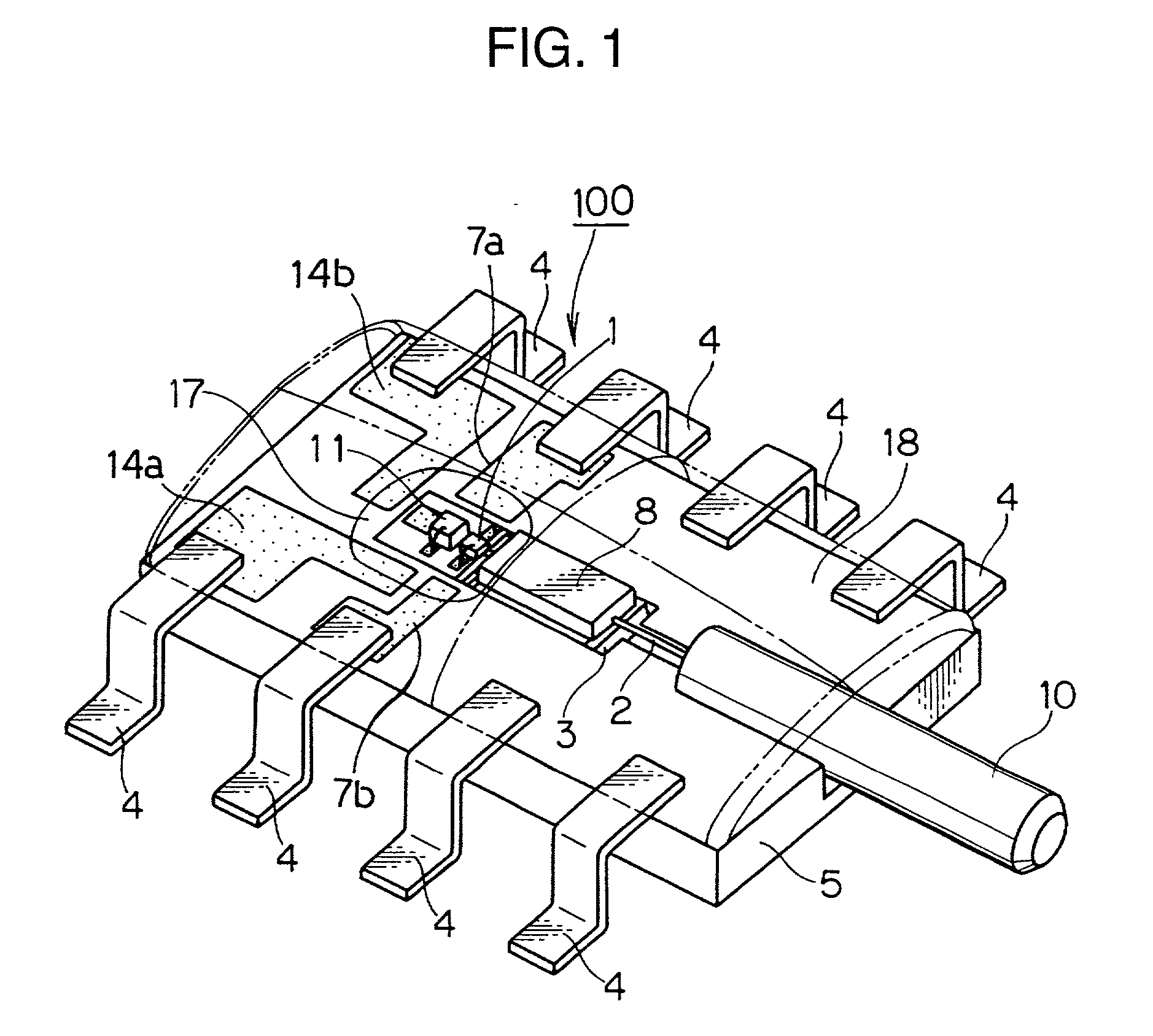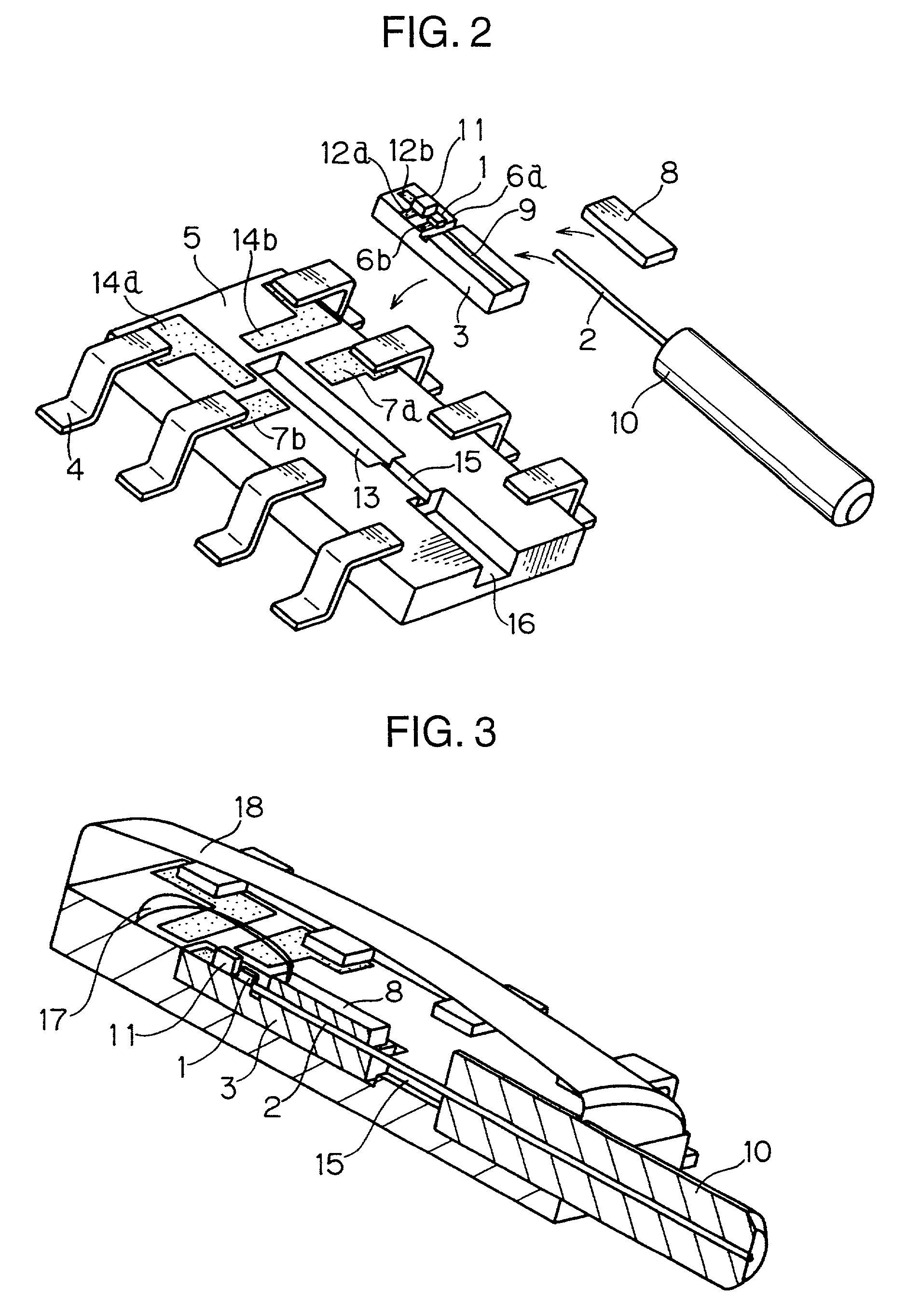Optical interconnection module
a technology of optical interconnection and module, applied in the field of optical interconnection module, can solve the problems of optical fiber micro-bends, difficult to precisely finish the outer shape of the mounting substrate 80 by dicing, and low output power, and achieve the effect of reliable interconnection characteristi
- Summary
- Abstract
- Description
- Claims
- Application Information
AI Technical Summary
Benefits of technology
Problems solved by technology
Method used
Image
Examples
first embodiment
[0053] First Embodiment
[0054] A first embodiment of the present invention is described. FIG. 1 shows a configuration of an optical interconnection module 100 in the first embodiment. FIG. 2 shows an exploded configuration of the optical interconnection module 100. FIG. 3 shows a sectional configuration of the optical interconnection module 100. FIG. 4 shows an appearance of the optical interconnection module 100.
[0055] As can be seen from the figures, the optical interconnection module 100 comprises a first mounting base member 3 and a second mounting base member 5. The first mounting base member 3 is made of, for example, a single crystalline silicon to which anisotropy etching can be processed. A light emitting device 1 such as a semiconductor laser, which is an example of an optical semiconductor device in the first embodiment, is fixed on the first mounting base member 3. The second mounting base member 5 is, for example, made of a ceramic material. Conductive patterns 7a, 7b, 1...
second embodiment
[0072] Second Embodiment
[0073] A second embodiment of the present invention is described. FIG. 5A shows a top appearance of an optical interconnection module 100A in the second embodiment, and FIG. 5B shows a bottom appearance of the optical interconnection module 100A. FIG. 6 shows a configuration of the optical interconnection module. FIG. 7 shows a sectional configuration of an optical interconnection portion of the optical interconnection module 100A.
[0074] A first mounting base member 103 is a single crystalline silicon substrate in which (100) surface of Miller indices corresponds to a principal plane. A V-shaped groove 109 on which an optical fiber 102 is held, a first cavity 106a in which a semiconductor laser 101 is contained, and a second cavity 106b in which a third mounting base member 119 is contained are respectively formed on the principal plane of the first mounting base member 103 by anisotropy etching. The third mounting base member 119 serves as a chip carrier.
[00...
third embodiment
[0096] Third Embodiment
[0097] A third embodiment of an optical interconnection module in accordance with the present invention is described. FIG. 11 shows an appearance of a surface emitting laser which is a semiconductor device used in the third embodiment. FIG. 12 shows a configuration of a third mounting base member 219 used in the third embodiment. FIG. 13 show a configuration of an optical sub-assembly in the third embodiment. FIG. 14 shows a configuration of an optical interconnection module 200 in the third embodiment.
[0098] As shown in FIG. 11, the surface emitting laser 201 (hereupon, called "laser chip")is an array type VCSEL (Vertical Cavity Surface Emitting Laser) having four light emitting portions 220a, 220b, 220c and 220d. The laser chip 201 has a width of 250 .mu.m, a length of 1000 .mu.m, a thickness of 100 .mu.m, and a pitch of the light emitting portions of 250 .mu.m. Four electrodes 206a, 206b, 206c and 206d are respectively provided on a light emitting surface (...
PUM
 Login to View More
Login to View More Abstract
Description
Claims
Application Information
 Login to View More
Login to View More - R&D
- Intellectual Property
- Life Sciences
- Materials
- Tech Scout
- Unparalleled Data Quality
- Higher Quality Content
- 60% Fewer Hallucinations
Browse by: Latest US Patents, China's latest patents, Technical Efficacy Thesaurus, Application Domain, Technology Topic, Popular Technical Reports.
© 2025 PatSnap. All rights reserved.Legal|Privacy policy|Modern Slavery Act Transparency Statement|Sitemap|About US| Contact US: help@patsnap.com



